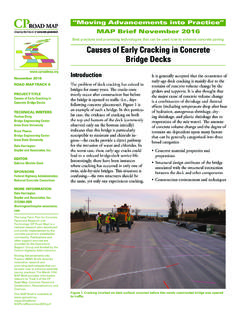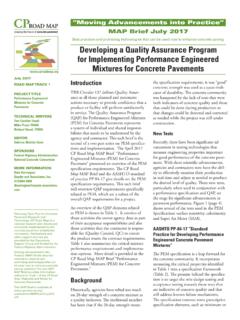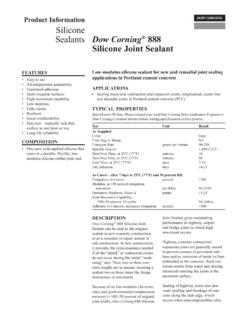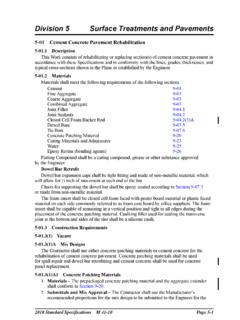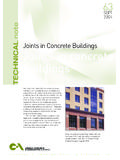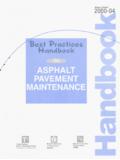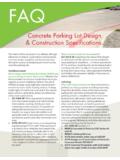Transcription of Partial-Depth Repairs for Concrete Pavements
1 2011 ROAD MAP TRACK 7 High-Speed Concrete pavement Rehabilitation and ConstructionAUTHORSD aniel P. FrentressFrentress Enterprises, LLCDale HarringtonSnyder and AssociatesSPONSORFHWAMORE INFORMATIONDale HarringtonSnyder and Associates(515) Advancements into Practice (MAP) Briefs describe innovative research and promising technologies that can be used now to enhance Concrete paving practices. MAP Brief 7-2 provides information relevant to Track 7 of the CP Road Map, High-Speed Concrete pavement Rehabilitation and Long-Term Plan for Concrete pavement Research and Technology (CP Road Map) is a national research plan developed and jointly implemented by the Concrete pavement stakeholder community.
2 Publications and other support services are provided by the Operations Support Group and funded by TPF-5(185). MAP Brief 7-2 is available at: Moving Advancements into Practice Describing promising technologies that can be used now to enhance Concrete paving practices MAP Brief 7-2: Partial-Depth Repairs for Concrete PavementsIntroductionPartial- depth Repairs are defined as the removal and replacement of small areas of deteriorated (or spalled) Concrete , typically in joints or cracks. The depth of deteriora-tion can vary from a few millimeters to the full depth of the pavement . Once they be-gin, spalls tend to grow or propagate under repeated thermal stresses and traffic Repairs restore structural integrity and improve ride quality.
3 Repairs of partially deteriorated joint areas also restore a well-defined, uniform joint -sealant reservoir prior to joint resealing. Partial-Depth Repairs have traditionally been used where joint or crack deterioration is in the top one-third of the slab and the existing load transfer devices (if any) are still functional. This approach has been used in most of the country, with the belief that if deterioration extends below the top one-third, then a full- depth repair is warranted. However, by using new milling equipment and Concrete mixtures, several cold-weather states have successfully demonstrated the use of Partial-Depth repair techniques in Pavements where deteriorated areas are deeper than the top one-third but slightly less than the top one-half of the slab.
4 Thus, Partial-Depth Repairs can now be used for a greater number of deteriorated joint MAP brief discusses three different types of Partial-Depth Repairs : Type 1 - Spot repair Type 2 - Long joint / crack repair Type 3 - Bottom half repairTypes 1 and 2 are standard Partial-Depth re-pairs (figure 1), and type 3 Repairs are those developed for special Repairs including the bottom half of the 1 - Spot RepairsSpot Repairs are appropriate in small, shal-low areas, where joint or crack deterioration is located in the top one-half of the slab (fig-ure 2). Spot Repairs are at least 10 in. long, but less than 6 ft, and are typically used for Pavements where the existing load transfer devices (if any) are still functional.
5 The most common method of removal for spot Repairs is the saw and chip method, although milling is becoming more popular for some 1. Typical (Type 1 and 2) Partial-Depth repairCP Road MAP Brief 7-2 Figure 2. Spot repair requiredType 2 - Long joint / crack RepairsLong joint / crack Repairs are Partial-Depth Repairs in transverse and longitudinal joints or cracks longer than 6 ft and extend-ing from one-third to one-half the depth of the Concrete pavement (figure 3). Removal is usually by milling, and a small jackhammer is used for the remaining part of the patch where the mill cannot V-shaped and straight milling heads have been used to remove deteriorated pavement for long joint / crack 3 Bottom Half RepairsAs depicted in figure 4, sometimes one or more corners or the edge of a Concrete pavement will deteriorate to the full depth for a short distance.
6 Bottom half Repairs are used for locations where the deterioration along the Partial-Depth re-pair exceeds T/2 in depth . This repair is for work performed in the bottom half of the pavement and its use should be lim-ited to the edges or cross- joint locations that are not greater than 18 in. Selection for Partial-Depth RepairsMaterial selection for Partial-Depth Repairs depends on these factors: Allowable lane closure time Ambient temperature Cost Size of repair Estimated performanceFigure 3. Longitudinal joint deterioration where Type 2 repair can be usedFigure 4. Deteriorated pavement corner where Type 3 repair can be used.
7 As shown in photo, tie rods are drilled at an angle into existing slab and then bent straight to tie the new patch with the existing pavement (strips of compressible material are positioned prior to placement of patch material).High-quality portland cement Concrete is generally accepted as the most appropriate material for the repair of existing Concrete mix developed by the Minnesota DOT, called 3U18, has been very successful for more than 30 years. This mix results in an 18 hour opening strength of 2,500 psi. Earlier open-ing times can be achieved with appropriate admixtures. Mix-ing is done either by hand, ready mix, or mobile Concrete mixers.
8 This mix can also be bought in 50 lb bags for small projects. CP Road MAP Brief 7-2 Cementitious 3U18 Recommended for Use in Partial-Depth Repairs 850 lbs Type I Cement 295 lbs of water 1,328 lbs of coarse aggregate (100% passing 3/8 in. sieve) 1,328 lbs of sand (55% passing #4 sieve) Target W/C of Type E Water Reducing and Accelerator airA wide variety of rapid-setting and high-early-strength proprietary materials have been developed for Partial-Depth Repairs . The materials are easy to place, achieve exceptional early strength, and have been approved for use by a number of highway agencies. They are more expensive but prove useful when traffic requires 5 hours or less opening strength.
9 These and other products are discussed in the Concrete Pave-ment Preservation Workshop Reference Manual (2008).Construction Steps for Partial-Depth RepairsConstruction steps for Partial-Depth Repairs are as Determine repair boundariesThe repair area is identified by sounding the deteriorated pavement using a chain, ball peen hammer, or steel pipe. Next, the boundaries for sawing or milling are marked on the pavement . The repair should extend 2 to 4 in. beyond the visible distressed Concrete RemovalThere are two common methods for removing deteriorated Concrete prior to a Partial-Depth repair : 1) sawing and chip-ping with a jackhammer and 2) and chipping with a jackhammerThe most common method for Partial-Depth spot Repairs is the saw and chip method (typically for Type 1 Repairs ), where a 2 in.
10 Saw cut is used to define the boundary area for the patch and a small (less than 35 lb) jackhammer is used to remove the outside edge of the saw cut in order to eliminate a smooth face and remove the rest of the existing Concrete . These patches are either square or rectangular (figure 5). MillingCold milling is another option for removing deteriorated Concrete (typically for Type 2 Repairs ). Milling produces a very rough, irregular surface that promotes a high degree of mechanical interlock between the repair material and the existing slab (figure 6).3. repair Area PreparationSandblasting, and compressed airblasting are normally suf-ficient for obtaining an adequately clean surface.
